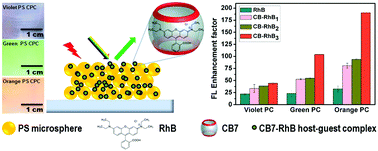Photonic band gap effect and dye-encapsulated cucurbituril-triggered enhanced fluorescence using monolithic colloidal photonic crystals†
Abstract
It is well known that enhanced fluorescence of dye molecules can be achieved by the formation of host–guest complexes that enhance the efficiency of chemical sensors, bio-imaging and photovoltaic devices. Herein, dual enhancement in fluorescence intensity was obtained by tuning three-dimensional (3D) periodic architectures of colloidal photonic crystals (CPCs) and host–guest chemistry. CPCs offer an appropriate platform with slow photon effects at the edges of a photonic band gap (PBG). These photons with decreased group velocity facilitate enhanced excitation and light extraction, which aid fluorescence enhancement; meanwhile, the host–guest chemistry of rhodamine B (RhB) with cucurbit[7]uril (CB7) decreases aggregation-caused quenching, which provides additional fluorescence enhancement. We demonstrated the augmentation of fluorescence intensity of a model dye, RhB, using size-tuned polystyrene (PS) CPC films where RhB forms an inclusion complex with the host, CB7. Compared to a planar PS film (control sample), over 150-fold fluorescence enhancement was achieved using the monolithic CPC films. Our strategy for generating dual enhanced fluorescence can stimulate the ultra-sensitive detection capabilities of fluorescence-based chemical and biochemical sensors, providing stronger signals and lower limits of detection.



 Please wait while we load your content...
Please wait while we load your content...